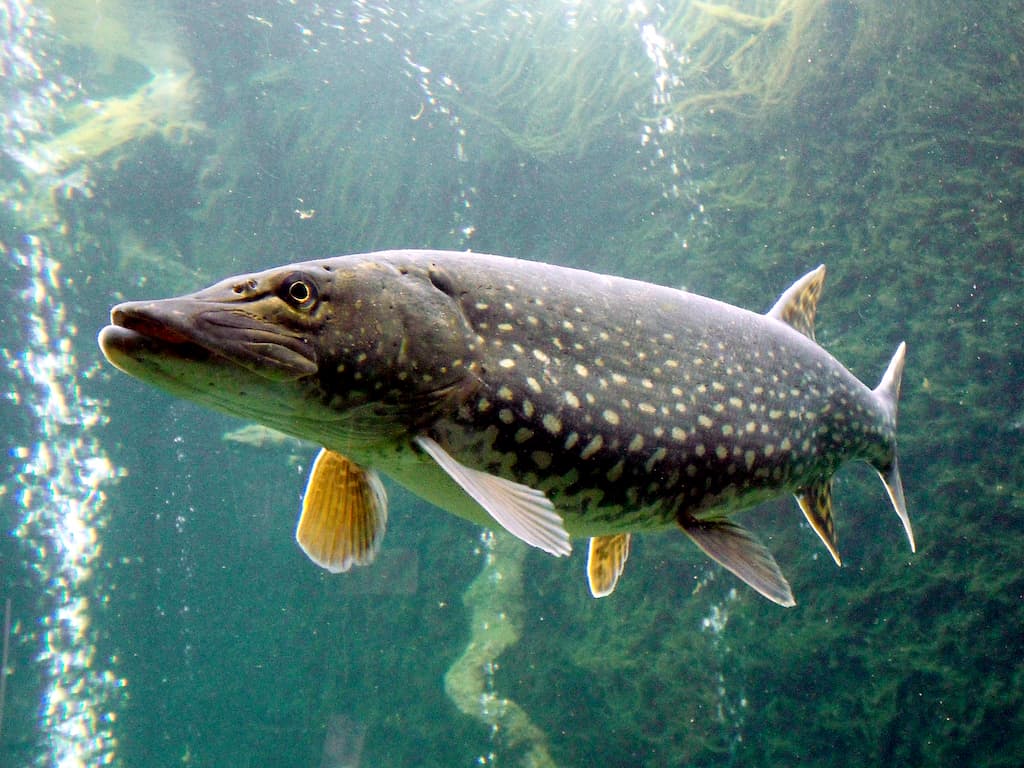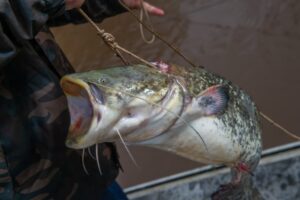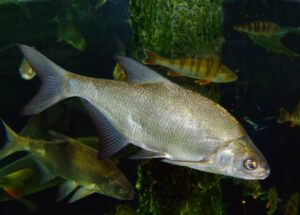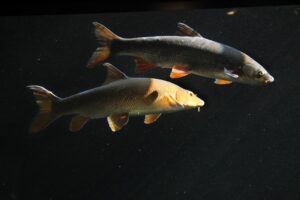Predatory fish : Northern Pike (Esox lucius)

The Pike (Esox lucius), known as Northern Pike, is a rapidly growing freshwater predator, the quintessential carnivorous fish.
Often depicted in comics or cartoons as the villainous fish voraciously trying to bite or gobble up the hero, its distinctive and unforgettable shape truly reflects its capabilities as a fierce predator. Sought after by the sports fisherman who must battle hard to land it, its delicious flesh is also highly appreciated by gourmets. Unfortunately, its breeding areas are becoming rare, and the presence of other predators feeding on the same prey or attacking the Pike directly (such as Catfish) has alarmingly decreased the number of these magnificent fish in public waters.

Fish Description : The Northern Pike
Identifying the Pike
The Northern Pike has a slender, spindle-shaped, and very elongated body, making it a highly hydrodynamic fish. Its head is characteristic, large, with a wide and flattened snout resembling a duck’s bill, equipped with 700 teeth. The lower jaw is prominent, and both jaws have several distinctive sensory pores. Its eyes are black, rimmed with gold, and immobile on top of the head.
The fins of the Northern Pike are distinctive; the small dorsal fin is located towards the rear of the body, near the caudal fin, and aligned with the anal fin. The pelvic fins are located in abdominal positions. This particular arrangement of the dorsal, caudal, and anal fins allows this fish to achieve sudden accelerations when hunting.
The general color of the Pike varies from dark green to bronze. The back and sides of the Northern Pike are striped with oblique yellowish marbling. The belly is white with a slight yellow tint. The fins of the Pike are yellow-reddish, spotted with black. The scales of the Pike are very fine and numerous.
| Class |
| Actinopterygii |
| Order |
| Esociformes |
| Family |
| Esocidae |
| Genus |
| Esox |
| Species |
| E. lucius |
| Binomial Name |
| Esox lucius (Linnaeus, 1758) |
Size, Weight, and Growth of the Northern Pike
The usual size of the Pike is 50cm, weighing 1kg. The largest specimens can reach 1.30m, weighing up to 25kg, generally females, often larger than males. The growth of the Northern Pike is very rapid: it generally measures 20 cm at one year of age, 40 cm at two years, and over 50 cm by the age of three.
Longevity and Lifespan
The lifespan of the Pike is 10 to 15 years for males and can reach 20 years (sometimes even 30 years) for females.
Understanding the Northern Pike’s Natural Habitat and Lifestyle
Pike’s Preferred Environments
The Pike is a widely distributed fish throughout Europe, with the exception of some specific areas like northern Spain, southern Italy, Scotland, and Norway.
It is a freshwater fish but can also be found in slightly brackish waters and in the southern Baltic Sea. The Pike particularly favors slow-moving waters, backwaters, ponds, lakes, and rivers, especially if these areas are deep and rich in vegetation.
It also prefers areas with submerged fallen trees. It is a solitary and highly territorial fish, with the size of its territory depending on the availability of food. It vigorously defends its territory against any intruders.
Northern Pike’s Feeding Habits and Diet
When the Pike is a fry, it primarily feeds on zooplankton and insects. It becomes a hunter and carnivore as it grows. Thanks to its binocular vision, it can attack its prey with great precision. It does not chase its prey but lurks in submerged grass or branches, using its anatomical advantages to make sudden and rapid strikes when prey passes by.
The Pike is not a scavenger and primarily feeds on live, sick, or injured fish but not dead ones. Its diet consists almost exclusively of fish (roach, bream, perch, rudd, trout, and even young pike), but being opportunistic by nature, it won’t hesitate to try ducklings, rodents, amphibians, small mammals, crayfish, or even birds within its reach.
It can attack prey weighing a third or half of its own weight. It’s worth noting that cannibalism is not uncommon among Pike. The Pike occupies a high position in the food chain.
Reproduction and Spawning Patterns of Pike
The Northern Pike reaches sexual maturity at around two years of age. Depending on climatic conditions and between the months of February and May when the water warms up to a temperature of 7 to 11°C, females will deposit their eggs in groups of about 50 on submerged vegetation.
The ideal place for spawning is a shallow, grassy area, such as a flooded meadow. A female lays approximately 15,000 eggs per kilogram of her weight. Despite being solitary predators, Pike gather during the spawning period.
After 1 to 2 weeks, the fry will hatch from the eggs but will remain attached to the vegetation for some time. They feed on zooplankton during their early days and begin hunting other fish when they reach a size of 5 to 7 cm.
The Role of Northern Pike in Angling and Gastronomy
The Northern Pike is highly prized for its gastronomic appeal. Many anglers dream of serving a river-caught Pike to their Sunday guests. The Pike also holds significance in fish farming due to its nobility and longevity. It is also used as a natural regulator in ponds and small lakes, limiting the growth of small fish populations.
For the sport angler, catching a Pike represents great pride, a challenging battle, and a memorable souvenir photo, before releasing it carefully back into the water because this belligerent predator won’t hesitate to turn on the imprudent angler. Northern Pike fishing is a beloved activity among all types of anglers, whether they are young or old, practice catch-and-release or not, experienced or occasional.
However, the increasing canalization work along our riverbanks is not favorable to its reproduction, causing the disappearance of its usual spawning areas.
Effective Techniques for Fishing Pike
Pike fishing is primarily done using lure or live bait techniques. Dead bait doesn’t interest it much since it’s a born hunter. Occasionally, it may be accidentally caught while targeting other species, as the presence of numerous panfish in the area can attract it from a distance.
Pike’s Conservation Status and Environmental Impact
The Northern Pike is classified as LC (Least Concern) in the IUCN Red List. The “Least Concern” category indicates that it is a widely distributed and abundant species.






